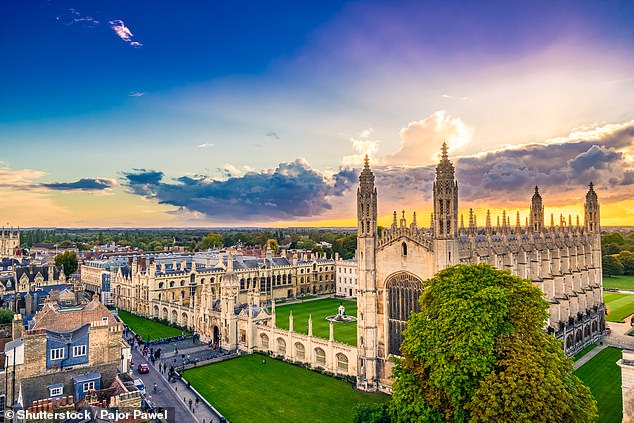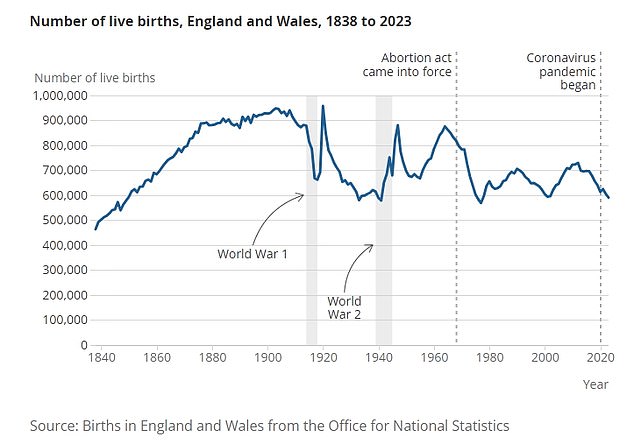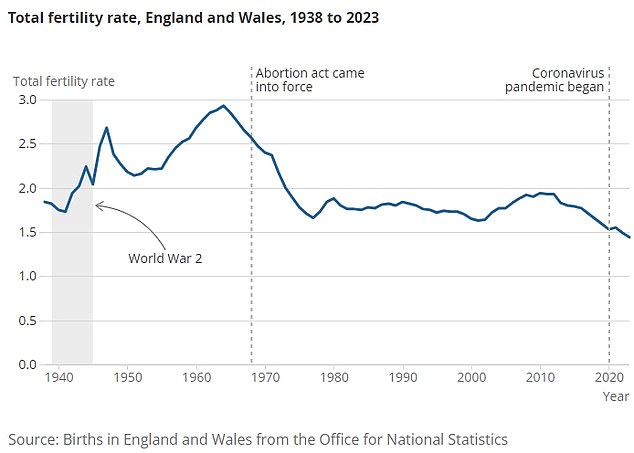Britain’s fertility time bomb was exposed today with the lowest birth rate ever recorded in official statistics.
England and Wales recorded an average of 1.44 children per woman of childbearing age in 2023, the Office for National Statistics (ONS) reported today.
Experts fear falling rates will lead to population decline as fewer working-age adults will trigger economic problems and a reliance on migration to prop up numbers.
Women focusing on their careers in their younger years have been blamed, while others have pointed to the cost of living and housing as factors.
Some areas of England and Wales recorded particularly low fertility rates.
One of these ‘baby deserts’ was the City of London, which had the lowest fertility rate with an average of 0.55 babies per woman.
Cambridge recorded the second lowest fertility rate at 0.91, followed by Brighton and Hove with 0.98 babies per woman.
By region, the biggest fall in fertility rates was in Wales, falling to 1.39 from 1.46, and the north-west of England, to 1.46 from 1.53.
Women of childbearing age, on average, have only had 1.44 children each in 2023, according to a report from the Office for National Statistics. This is the lowest level recorded since records began in 1938.

Cambridge recorded one of the lowest fertility rates in England and Wales, with less than one baby per woman of childbearing age.
By contrast, London, the North East and the West Midlands, while continuing to see overall declines, had the smallest falls of all regions.
The fertility rate collapse seen in the ONS report is part of a wider trend that has been observed since 2010, and more widely since the 1960s.
By age group, the decline has been more pronounced among women in their 20s.
Birth rates among women in their 20s have fallen nearly 80 percent since the 1960s, from 182 births per 1,000 women to just 38.6 births per 1,000 women today.
Put another way, today only a fifth of British women will have had a child by the age of 25, the lowest proportion ever recorded.
The collapse of fertility has been accompanied by a drop in births.
England and Wales alone recorded 591,072 live births in 2023, the lowest figure since 1977.
While no area in England and Wales recorded a fertility rate at or above what experts call the replacement level of 2.1, some came close.

England and Wales alone recorded 591,072 live births in 2023, the lowest figure since 1977
Luton in Bedfordshire had the highest fertility rate of both nations at 2.01.
It was followed by the London borough of Barking and Dagenham, with a rate of two babies per woman, and Slough, in Berkshire, with a rate of 1.93.
Numerous factors have been blamed for the collapse of fertility rates in modern Britain.
Some have cited how women simply enjoy the independence that society offers them now compared to a century ago and choose not to have children.
In a similar trend, some women may only choose to have children later in life, and therefore less overall, and instead focus on their careers.
For men, lifestyle factors, such as the increasing prevalence of obesity in many countries, are also thought to be having a negative impact on fertility.
Increasing pressures on the cost of living, especially the price of childcare and housing, is another factor slowing down the work of couples who have children or decide to have more than one and, as a result, may reduce the rate total fertility.

Elon Musk (pictured), who boasts of ‘always beating the drum’, has been warning about a decline in births for years
But without replenishing an aging population, scientists say public services and economic growth are at risk.
Steadily declining birth rates will also put additional pressure on the NHS and social care as there will be fewer young people to work in services that an older population will need.
The ONS report showed that the average age of fathers increased to 33.8 years, while the average age of mothers remained stable at 30.9 years.
While the age of mothers has remained stable, it is due to a historic increase in when women decide, on average, to have children later, if at all.
In comparison, almost 60 percent of women born in the 1940s had at least one baby by age 25; today this figure has dropped to 20 percent.
Britain is not the only country suffering from a baby crisis.
Earlier this year, scientists warned that 75 percent of countries would face this demographic problem by 2050.
By 2100, this figure could rise to 97 percent of all nations, in what experts have described as a “staggering social change.”
Experts, and even celebrities like Elon Musk, have been warning about the global threat of depopulation for years.
Some countries are taking steps to try to reverse the trend.
France, which already enjoys a higher fertility rate than Britain (1.8), plans to offer a free “fertility check” to all young people aged 18 to 25, both men and women, to address the ” scourge” of infertility, according to President Emmanuel Macron.

